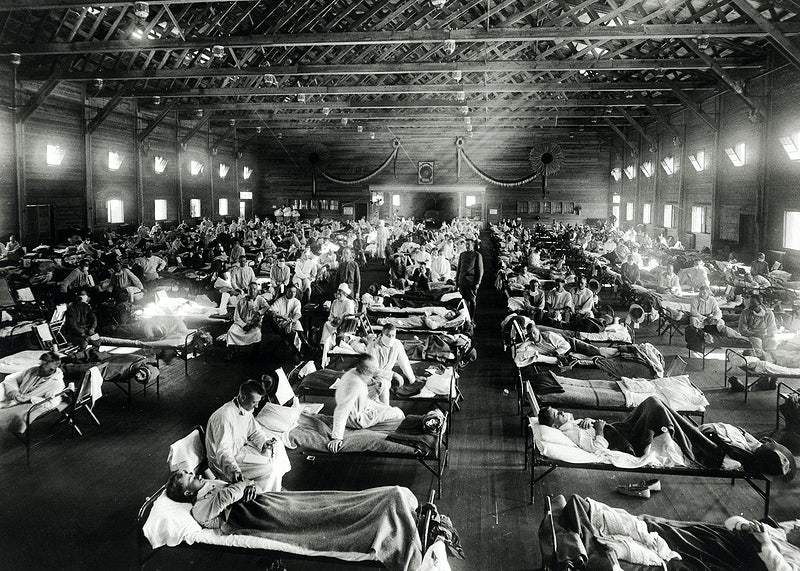© EnterTheFuture.Today
Pandemic
- CHAPTER 2 -
Pandemic
Humanity has been able to survive the worlds Pandemics, but not without great losses. Today, Pandemics remains one of humanities greatest threats. Made up of an army that cannot be seen by the naked eye, this invisible enemy is one of humanities most difficult to combat. From what we learned so far; we can be sure that future pandemics are likely to happen. The question is, can we better prepare ourselves to survive them and reduce losses.
A pandemic occurs when a particular bacteria or virus infection spreads among a species at a global scale. What is ironic is that the species that these bacterium / viruses infects, are its best ally. In the case of humans, and us being social creatures, we can unknowingly pass on viruses as we interact with others. This may only spread to a small number of people or lead to a major outbreak with numerous people being infected. If left unchecked the outbreak could become an epidemic within a certain region. If the epidemic spills over into other regions, it could become a pandemic.
Centuries ago, societies were unable to control outbreaks due to their lack of knowledge about viruses and bacterium.
Today we know viruses and bacterium exist, we know how they work and the different ways they spread. We have even developed vaccines to immune people against previous infections. So why does mankind keep encountering new Pandemics.
A pandemic occurs when a particular bacteria or virus infection spreads among a species at a global scale. What is ironic is that the species that these bacterium / viruses infects, are its best ally. In the case of humans, and us being social creatures, we can unknowingly pass on viruses as we interact with others. This may only spread to a small number of people or lead to a major outbreak with numerous people being infected. If left unchecked the outbreak could become an epidemic within a certain region. If the epidemic spills over into other regions, it could become a pandemic.
Centuries ago, societies were unable to control outbreaks due to their lack of knowledge about viruses and bacterium.
Today we know viruses and bacterium exist, we know how they work and the different ways they spread. We have even developed vaccines to immune people against previous infections. So why does mankind keep encountering new Pandemics.
Big Challenges
Their ability to mutate can make it difficult to develop an effective vaccine.
Mankind's ability to travel between counties / continents within a days time makes it difficult to contain the spread of infected people.
Because we can't see viruses and bacteria with naked eye, we usually only become aware of it's spread when numerous people become sick.
How To Fight It
This is usually achieve through disinfecting, quarantining, social distancing, and wearing P.P.E. (Personal Protective Equipment)
Treating the sick to improve their health and, if possible, to make it so their no longer infectious to others.
Vaccines make a person's immune from becoming infected by particular viruses and bacterium.
A pandemic is a lot like a forest fire, .....ifcaught early it might be extinguished with limited damage. If allowed to smolder, undetected, it can grow to an inferno that can spread quickly beyond our ability to control it.
If a severe pandemic materializes, all of society could pay a heavy price for decades of failing to create a rational system of healthcare that works for all of us.
The worst pandemic in modern history was the Spanish flu of 1918, which killed tens of millions of people. Today with how interconnected the world is, it would spread faster
Worst Pandemics
...and how we survived them

Plague of Justinian (541–542 AD)
CAUSE: Bubonic Plague
DEATH TOLL: 25–100 million
HOW WE SURVIVED: Over time the viruses to become less lethal.
CAUSE: Bubonic Plague
DEATH TOLL: 25–100 million
HOW WE SURVIVED: Over time the viruses to become less lethal.

AKA: The Black Plague
CAUSE: Bubonic Plague
DEATH TOLL: 200 Million
HOW WE SURVIVED: Quarantines
CAUSE: Bubonic Plague
DEATH TOLL: 200 Million
HOW WE SURVIVED: Quarantines

AKA: 1918 Flu Pandemic
CAUSE: H1N1 virus
DEATH TOLL: 100 Million
HOW WE SURVIVED: Over time the viruses to become less lethal.
CAUSE: H1N1 virus
DEATH TOLL: 100 Million
HOW WE SURVIVED: Over time the viruses to become less lethal.

AKA: Auto Immune Defiency Syndrome
CAUSE: HIV Virus
DEATH TOLL: 36 Million
HOW WE SURVIVED: By reducing the spread. This was largely accomplished by educating the public how to protect themselves from getting infected.

CAUSE: Cholera
DEATH TOLL: 1 million
HOW WE SURVIVED: Identifying contaminated water sources and prevent people from drinking from them.
DEATH TOLL: 1 million
HOW WE SURVIVED: Identifying contaminated water sources and prevent people from drinking from them.
Pandemic History
1350
1350
1492
1721
1721
- Onesimus an eslaved African shares with his slaveholder, Cotton Mather. the knowledge of inoculation, a procedure that Africa tribes used to prevent the spread of diseases such as smallpox. Cotton Mather pushed for innocalation in Boston during the smallpox outbreak saving many lives.
1796
1796
- Edward Jenner develops the smallpox vaccine which is the first successful vaccine.
1852–1860
1852–1860
- Third Cholera Pandemic
- Dr John Snow helps curtail the cholera spread by tracing the source to a public water pump in Soho, London.
1855
1855
- The Third Plague Pandemic
1889
1889
- Russian Flu
1918
1918
- Spanish Flu
1957
1957
- Asian flu
1981
1981
2003
2003
- SARS
2019
2019

The Columbian Trade
" Following the arrival of the Spanish in the Caribbean, diseases such as smallpox, measles and bubonic plague were passed along to the native populations by the Europeans. With no previous exposure, these diseases devastated indigenous people, with as many as 90 percent dying throughout the north and south continents." History.com
Articles